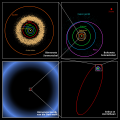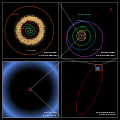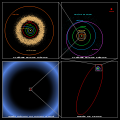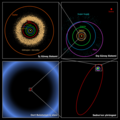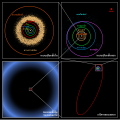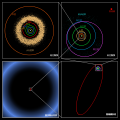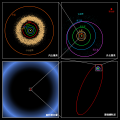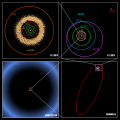File:Oort cloud Sedna orbit.jpg

Original file (2,499 × 2,499 pixels, file size: 542 KB, MIME type: image/jpeg)
This file is from a shared repository and may be used by other projects. The description on its file description page there is shown below.
| DescriptionOort cloud Sedna orbit.jpg |
These four panels show the location of trans-Neptunian object 90377 Sedna, which lies in the farthest reaches of the Solar system. Each panel, moving clockwise from the upper left, successively zooms out to place Sedna in context. The first panel shows the orbits of the inner planets and Jupiter; and the asteroid belt. In the second panel, Sedna is shown well outside the orbits of Neptune and the Kuiper belt objects. Sedna's full orbit is illustrated in the third panel along with the object's location in 2004, nearing its closest approach to the Sun. The final panel zooms out much farther, showing that even this large elliptical orbit falls inside what was previously thought to be the inner edge of the spherical Oort cloud: a distribution of cold, icy bodies lying at the limits of the Sun's gravitational pull. Sedna's presence suggests that the previously speculated inner disk on the ecliptic does exist. |
||||||
| Date | |||||||
| Source | [1] [2] Splitzer Space Telescope Released Images about Sedna | ||||||
| Author |
Image courtesy of NASA / JPL-Caltech / R. Hurt Original text courtesy of NASA / JPL-Caltech |
||||||
| Permission (Reusing this file) |
|
||||||
| Other versions |
[edit]
|
References
- JPL. Most Distant Object in Solar System Discovered archive copy at the Wayback Machine. Press release: Jet Propulsion Laboratory. March 15, 2004.
Captions
Items portrayed in this file
depicts
File history
Click on a date/time to view the file as it appeared at that time.
| Date/Time | Thumbnail | Dimensions | User | Comment | |
|---|---|---|---|---|---|
| current | 02:48, 19 September 2005 |  | 2,499 × 2,499 (542 KB) | imagescommonswiki>Bricktop | larger |
File usage
The following file is a duplicate of this file (more details):
- File:Oort cloud Sedna orbit.jpg from Wikimedia Commons
There are no pages that use this file.
Metadata
This file contains additional information, probably added from the digital camera or scanner used to create or digitize it.
If the file has been modified from its original state, some details may not fully reflect the modified file.
| _error | 0 |
|---|




